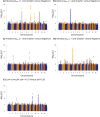Sequence variants associating with urinary biomarkers
- PMID: 30476138
- PMCID: PMC6423415
- DOI: 10.1093/hmg/ddy409
Sequence variants associating with urinary biomarkers
Abstract
Urine dipstick tests are widely used in routine medical care to diagnose kidney and urinary tract and metabolic diseases. Several environmental factors are known to affect the test results, whereas the effects of genetic diversity are largely unknown. We tested 32.5 million sequence variants for association with urinary biomarkers in a set of 150 274 Icelanders with urine dipstick measurements. We detected 20 association signals, of which 14 are novel, associating with at least one of five clinical entities defined by the urine dipstick: glucosuria, ketonuria, proteinuria, hematuria and urine pH. These include three independent glucosuria variants at SLC5A2, the gene encoding the sodium-dependent glucose transporter (SGLT2), a protein targeted pharmacologically to increase urinary glucose excretion in the treatment of diabetes. Two variants associating with proteinuria are in LRP2 and CUBN, encoding the co-transporters megalin and cubilin, respectively, that mediate proximal tubule protein uptake. One of the hematuria-associated variants is a rare, previously unreported 2.5 kb exonic deletion in COL4A3. Of the four signals associated with urine pH, we note that the pH-increasing alleles of two variants (POU2AF1, WDR72) associate significantly with increased risk of kidney stones. Our results reveal that genetic factors affect variability in urinary biomarkers, in both a disease dependent and independent context.
© The Author(s) 2018. Published by Oxford University Press.
Figures




References
-
- Suhre K., Wallaschofski H., Raffler J., Friedrich N., Haring R., Michael K., Wasner C., Krebs A., Kronenberg F., Chang D. et al. (2011) A genome-wide association study of metabolic traits in human urine. Nat. Genet., 43, 565–569. - PubMed
-
- Tesch G.H. (2010) Review: Serum and urine biomarkers of kidney disease: a pathophysiological perspective. Nephrology, 15, 609–616. - PubMed
-
- Simerville J.A., Maxted W.C. and Pahira J.J. (2005) Urinalysis: a comprehensive review. Am. Fam. Physician, 71, 1153–1162. - PubMed
-
- Rao P.K. and Jones J.S. (2008) How to evaluate ‘dipstick hematuria’: what to do before you refer. Cleve. Clin. J. Med., 75, 227–233. - PubMed

